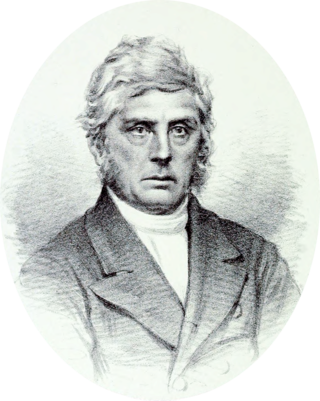
John Dunmore Lang was a Scottish-born Australian Presbyterian minister, writer, historian, politician and activist. He was the first prominent advocate of an independent Australian nation and of Australian republicanism.

The Presbyterian Church of Eastern Australia (PCEA) is a small Presbyterian denomination which was formed in Sydney on 10 October 1846 by three ministers and a ruling elder. As of December 2012 it consists of 13 pastoral charges with a total of 17 regular preaching points, 12 serving ministers, 1 minister without charge, 6 retired ministers and a community of about 800.

St. Andrew's Presbyterian Church is the oldest Presbyterian church in Ottawa, Ontario, Canada.

The Presbyterian Church in Canada is a Presbyterian denomination, serving in Canada under this name since 1875. The United Church of Canada claimed the right to the name from 1925 to 1939. According to the Canada 2001 Census 409,830 Canadians identify themselves as Presbyterian, that is, 1.4 percent of the population.

Knox College is a postgraduate theological college of the University of Toronto in Toronto, Ontario, Canada. It was founded in 1844 as part of a schism movement in the Church of Scotland following the Disruption of 1843. Knox is affiliated with the Presbyterian Church in Canada and confers doctoral degrees as a member school of the Toronto School of Theology.

Knox Presbyterian Church is a Presbyterian church in downtown Toronto, Ontario, Canada.

The Reformed Presbyterian Church of Australia is a Reformed church in Australia. It is a small Presbyterian church numbering slightly over 200 persons with its largest congregation in the area of Geelong, Victoria. The first church, in Geelong, was started in 1858. It links itself historically with those in the Covenanter movement in Scotland who did not accept the settlement of Presbyterianism in that country in 1690, and has sister denominational relations with the Reformed Presbyterian churches of North America, Ireland, and Scotland. Fraternal relations exist with the Presbyterian Church of Eastern Australia.

James Forbes was a Scottish-Australian Presbyterian minister and educator. He founded the Melbourne Academy, later Scotch College.

The Knox United Church, began as Knox Presbyterian Church in Scarborough, Toronto, Ontario, Canada, in a wood-frame church built in 1848, the result of the Church of Scotland disruption, that led to the formation of the Presbyterian Church of Canada in Connection with the Free Church of Scotland.

The Scots' Church is a Presbyterian church in Melbourne, Victoria, Australia. It was the first Presbyterian church to be built in the Port Phillip District and is located on Collins Street. It is a congregation of the Presbyterian Church of Australia and has been described as "an icon for well over a hundred years".

Lonsdale Street is a main street and thoroughfare in the Melbourne central business district, Australia. It runs roughly east–west and was laid out in 1837 as one of Melbourne's original boundaries within the Hoddle Grid. The street extends from Spring Street in the east to Spencer Street in the west.
William McIntyre was a Scottish-Australian Presbyterian minister and educator.

Thomas M'Crie was a Presbyterian minister and church historian. He was a Scottish Secession minister who joined the Free Church of Scotland and served as the Moderator of the General Assembly to that church 1856/57.
The Free Presbyterian Churchof Australia is a denomination which currently consists of four congregations in fellowship with the Free Presbyterian Church of Ulster. There are congregations in Port Lincoln, Perth, Lock and Kingston, Tasmania.
The Rev William Miller (1815–1874) was a Scots-born minister of the Free Presbyterian Church of Victoria who served the John Knox Church, cnr Little Lonsdale and Swanston Streets, Melbourne 1851–64, and was the first Chairman of the council of Scotch College in Melbourne.

Scots Church is a stone Uniting Church building on the southwest corner of North Terrace and Pulteney Street in Adelaide, the capital city of South Australia. It was one of the early churches built in the new city in 1850. It was built as the "Chalmers Free Church of Scotland".

John Gardner was a Scots-born Presbyterian minister in Adelaide, South Australia, the first incumbent of Chalmers Free Church of Scotland, now Scots Church, North Terrace, Adelaide. He later served at Launceston, Tasmania and Queenscliff, Victoria.
Ralph Drummond was the first minister of a Presbyterian Church in South Australia.
Arthur Irving Davidson was an Australian Presbyterian Minister, Military Chaplain and Australian rules footballer who played for the Fitzroy Football Club in the Victorian Football League (VFL).

Adam Cairns (1802–1881) was a Scottish Presbyterian minister. In 1837 he became minister of Cupar. At the disruption in 1843 he sided with the Free Church, and was employed in parochial work until 1853, when he accepted a commission from the Colonial Committee of the Free Church to proceed to Melbourne, where he arrived in September of that year. There, amidst the excitement of the gold fever, he laid the foundations of Presbyterianism in Victoria, acting as pastor of the Chalmers Church Congregation till 1865, when, his health failing, he became an emeritus minister, retaining his standing in the Church without pastoral charge. He died on his birthday January 30, 1881.














